Trans Identity: When Parents Try to Win the Debate, Their Kids Alienate.
Here's how to fix it: "Stop Bringing a Debate to a Gender Identity Nickel Arcade" Gender Identity Ideation Series Part 3
Note: The "play” button at the top is not a decoration. It is an audio-taped version of myself reading this essay.
Also note: This essay is the third part of a three part essay. In my essay titled “When Your Kid Comes Out as Trans, Doing Nothing Isn’t an Option” which is not a part of this series, but which I still recommend reading for my newer subscribers, I discuss why it is ideal to use this trans identity ideation as a wake up call that something needs to change, before any transition has occurred– rather than waiting and hoping this will resolve on its own.
I discussed in the first essay of my gender identity ideation series, titled “Trans: When Coping Mechanism Becomes Identity” how I believe that ideation begins– as an attempt to solve a problem or meet an unmet need through the most easily accessible and widely available sense-making framework around.
In the second part of this essay series, titled “Trans: When Adolescent Survival Strategy Meets Family Breakdown” I’ve discussed how family dynamics even in the most well-intentioned families like mine, can lead to alienation over gender identity disagreements, without parents even realizing it. Please read part two before continuing with part three.
Trans: When Adolescent Survival Strategy Becomes Family Breakdown
Note: The "play” button at the top is not a decoration. It is an audio-taped version of myself reading this essay. Also note, there are videos in the first section of this essay, so if you are a listener, keep this in mind.
In this third and (for now) final essay in my ideation series, I will discuss the importance of retiring ineffective parenting strategies such as trying to win an argument over identity or gender ideology with your kids. I will explain why the common non-affirming “debate” strategy isn’t just ineffective, but relationship-destroying and I will focus on how I as a detransitioner who lived this for years, think that parents and caregivers of gender questioning youth can reframe their thinking about how to talk about gender with their kids, so as to achieve better outcomes.
The Gender Identity Debating Society Convenes Around Thousands of Tables Across the West, (UN)Surprisingly No One Emerges Victorious.
Parents often tell me that no matter what they say to their trans-identified child in an effort to reconnect them with their natal sex identity, nothing seems to work. They describe shouting matches at the dinner table with a daughter who insists she is a boy. These parents are often quick to point out the non-factual nature of gender ideology—both in general and as it pertains to their own child. They may cite her XX chromosomes, her history of gender conformity in childhood, or how she once dressed up as a princess for Halloween.
When these conversations become toxic firestorms, parents sometimes pivot to what they think is a new, better approach: bombarding their child with tragic stories of transition regret, post-surgical complications, studies on rapid-onset gender dysphoria, or medical evidence warning of the dangers of interventions—even when the child hasn’t expressed a desire to medically transition.
Unwittingly, these parents may end up escalating their child’s desire to transition by reacting from a place of panic. These confrontations almost always backfire, and end up intensifying the tension between parent and child. Some parents persist anyway, continuing to argue over every aspect of gender ideology—from male athletes in women’s sports to the biology of sex—hoping that something, anything, will finally break through.
From the ages of 12-24, my interactions with my parents were defined by probably hundreds of hours of these heated arguments over my trans identity that you are currently entrenched in. There’s a reason why arguments grounded in biological reality—however factually accurate—so often end in shouting matches when directed at a gender-questioning child. There’s a reason why showing a teenager videos of detransitioners describing surgical complications and regret is more likely to be met with dismissal, anger, or emotional shutdown than open-minded reflection.
In my experience, well-meaning parents—my own included—often fundamentally misunderstand why their child has latched onto a transgender identity in the first place. Because they misinterpret the underlying cause, and as a result, they respond in ways that only deepen the parent-child divide. The more strained the emotional atmosphere becomes at home, the more desperate and reactive the parents grow—and the more their child doubles down on the identity in question.
In this paper, I will explore why it is crucial for parents to respond to their child’s gender questioning and desire to transition, in its early phases, not as a medical emergency or an ideological battlefield, but as a form of adolescent identity exploration. That’s not to say this particular identity path is like all others—it’s not. The transgender framework uniquely promotes the belief that becoming an entirely different kind of person is both the resolution to a variety of developmental distresses and an embodiment of “true authenticity,” and it involves high-stakes interventions which are often irreversible.
Additionally, transgender identities now enjoy widespread social and institutional support, such that almost nothing stands between an 18-year-old and a gender clinic—except, perhaps, their parents. The longer a caustic parent-child relationship continues to flourish in the wake of a trans identity declaration, the higher of a chance there is that the kid will medicalize or become estranged from their parents (or both).
So let’s examine how different affirming and non-affirming parenting styles tend to engage with a young person’s gender questioning, why these approaches often backfire (whether by pushing the child toward transition or by fostering estrangement), and what parents can do instead to support their child more effectively—without losing them in the process.
It’s Not Just About Indoctrination—It’s About Individuation
Let’s be clear: all human beings are born with the innate ability to distinguish between males and females. It’s a basic survival necessity. So when a child above the age of seven-ish—especially a preteen or teenager—comes to strongly believe they are the opposite sex, it isn’t simply because they “came across the idea at school.” Millions of kids across the Anglophone world have encountered the same concepts, and only a small fraction of them will go on to identify as transgender.
Indoctrination may certainly plant the seed, in far higher numbers of kids than it ever has before— but for that seed to grow into an identity powerful enough to override a child’s natural developmental trajectory, the soil has to be fertile. Your child’s entire class may be thoroughly indoctrinated to believe that some people are born in the “wrong” body, that sex is fluid, and that there are infinite genders. But there is at least one unique reason—if not more—that your child believes they, specifically, were born in the wrong body. That distinction matters. Plenty of young people absorb these ideas in the abstract, or apply them empathetically to others, without internalizing them as personal truths. Only a subset of those exposed to gender ideology will adopt it as a self-concept.
So no, indoctrination alone doesn’t explain how you ended up here. If that’s your working theory, you’re missing something essential about the nature of your child’s gender questioning. That missing piece is also probably why you think that arguing about facts will get your kid out of this. Your role as a parent to an adolescent isn’t to counter gender identity ideology indoctrination with fact sheets or rebuttals. Your role is to understand what this identity is doing for your child—what need it’s trying to fulfill, what it’s helping them cope with or avoid—and to become their partner in addressing those needs in healthier, more sustainable ways. There is a reason your child feels that something about their current, biologically-based identity isn’t working. If you can work with them to uncover what that is, you’ll be doing them a profound service.
To understand why your child may have gravitated toward a trans identity, it helps to understand the psychological task of individuation. Individuation is the process through which a person becomes a psychologically distinct and autonomous self—separate from their parents, peers, and inherited roles. It is a normal, necessary, and often messy part of growing up. In adolescence, this drive kicks into high gear. Teenagers begin to ask questions like: Who am I? What do I believe? How am I different from my family? What makes me, me?
This is where things often get painful for parents—especially those who had close, affectionate bonds with their child during the preteen years. Many are blindsided when their once cuddly, talkative child becomes withdrawn, irritable, or disinterested in family time. Some parents take this personally and grieve what feels like a rupture in the relationship. And when disagreements over gender identity enter the picture, that gap can start to feel like a canyon overlooking an abyss. Parents may interpret their child’s emotional distance as ideological possession or rejection, when in many cases, what’s happening is something far more ordinary: the child is becoming a teenager. They are developing boundaries, seeking privacy, and trying to define themselves apart from the adults who raised them. That’s not betrayal—it’s individuation.
Gender debates do have a way of accelerating the distance. A teenager who already needs space to figure out who they are is going to be even less inclined to open up if every conversation becomes a battleground. This developmental drive can manifest in countless ways—through clothing, music tastes, politics, general rebellion against rules, or by adopting new belief systems. For today’s young people, particularly those who feel emotionally disconnected, “odd,” socially awkward, anxious, or misunderstood, the trans identity offers a ready-made answer to those identity questions. Trauma associated with one’s sexed body, and/or a young person’s self-perceived inability to live up to the expectations placed upon them as a son or daughter by their parents, or of those expectations placed upon young men and women by society, also get rationalized through the all-encompassing trans identity framework.
It doesn’t just say you’re different—it says you’re not a broken girl you’re a special trans boy. The trans identity doesn’t just challenge norms—it gives a script for how to feel empowered in doing so. And most of all, it allows a young person to carve out a sharp boundary between their “true” self and the people who “just don’t understand.” This black and white, rigid thinking is archetypically adolescent and it is especially tantalizing to those adolescents who miss social cues and fail to understand the nuances of the world and its many, beautiful (and confusing) shades of grey.
In a world where individuation has become harder—where young people are often over-parented, floating aimlessly in a household without boundaries or structure, without having the life skills to pitch their rebellion outside the home, emotionally isolated, or buried under an onslaught of unrealistic expectations—transgender identity offers what appears to be a coherent escape hatch. It gives meaning to pain and confusion. It offers a path out of the distress. But it does so by encouraging young people to reject their own bodies, rewrite their pasts, and stake their future on permanent medical interventions.
Why Did Gen Z Become the TransGen(d)eration?
To those who don’t yet know me: hi, my name is Maia, and I was born in the prehistoric year of 1999. That makes me both technically young and, somehow, a relic of another century… and another millennium. I don’t remember anything about the year I was born, but most of you reading this probably do. Apparently…
That’s not the kind of self-discovery individuation is meant to achieve. Instead, trans identity requires the validation of everyone else and lends itself to inherent instability because it is not an identity based on reality. The task, then, is not to shut down your child’s individuation process, but to reframe it. Your child is trying to grow, to differentiate, to make sense of their inner life and outer world. That’s not inherently pathological—it’s developmental. But, the transition path they’ve chosen to walk is dangerous. They haven’t chosen this path because they are inherently broken (as many of them see themselves) nor because they are totally delusional (as you may at times see them). They’ve chosen the trans framework because their needs are real and urgent, and this is the only framework they've found that seems to explain and address them.
If you can see your child’s identity exploration not as a deliberate, defiant rejection of truth or a rejection of you as a parent, but as a valiantly misdirected attempt at growth, you’ll be better positioned to help them forge a healthier, more grounded sense of self. Ideally, it will be a sense of self which does not require your constant validation or intervention to maintain.
Individuation is a natural developmental task: the process by which an adolescent young person begins to separate their identity from their parents’, claiming the right to their own feelings, their own decisions, and ultimately their own life. Every adolescent must undergo it. But when a child’s attempts at individuation are met only with panic and rejection—when their explorations, however clumsy, are treated as existential threats—the process is no longer one of growth. It becomes war. It becomes about survival.
And no, that doesn’t mean that affirmation is the answer. Both affirmation and non-affirmation without exploration trap kids in an identity they’ve created which we have already established as being a coping mechanism aimed at resolving distress and meeting unmet developmental needs through extreme medical risks which the risk-averse child is drawn to because he or she has been convinced that these risks are ‘safe’ because the experts say so. The key with how to handle these situations is to explore your child’s mindset, figure out which developmental needs they’re trying to meet with this identity, and to find healthier ways for the kid to meet those needs.
The unfortunate nature of trans identity as an individuation activity is that it does not actually achieve the goal of becoming a separate person from one’s parents, because it requires the parents to buy in and go along with it. The trans identity is the individuation attempt of the confused, distressed youngsters who lack the emotional resilience, life skills, independence or freedom to individuate in healthier ways– largely because of how they were raised by their parents and by the broader culture. That is, at least, my assessment.
Where Well-Intentioned Families Go Wrong

When parents first discover that their child identifies as transgender, they often react in one of two broad ways which reflect their general parenting style; either authoritarian or permissive. Both of these extreme strategies, though opposite in approach, frequently lead to the same outcome: parental panic, which further alienates them from their child and makes their child more likely to run to the gender clinic the first chance they get.
The following observations are purely based on my own experience, the experiences of the families I’ve worked with over the last few months, and my analysis of the activist parents of famous “trans kids” whom I’ve spent the last more than a decade of my life becoming acquainted with on the internet.
Both of these parenting styles I will be describing in their extremes so as to maintain clarity over which traits I am discussing. There are parents who exist on these extremes, but most families will probably recognize themselves within more traits of one model or the other— perhaps with a mixture of them both. These sections focus on trends and patterns, not on the myriad of possible permutations of every possible family out there.
How This Shows Up in Tiger Parenting (Authoritarian Parenting)
Some parents, authoritarian parents (not to be confused with authoritative) whom I refer to as “tiger parents” react to their teenager’s transgender declaration by holding a firm and visible line.
They may begrudgingly allow their child to dress however they wish but only because they realize that a teenager with her own pocket money cannot truly be stopped from buying her own clothes. Or some may restrict her from free self-expression. They may express open disappointment in their child’s gender nonconformity, fearing it’s either a stepping stone to medical transition or something that will make their already socially awkward child even more isolated or "abnormal." These parents will refuse to use new names or pronouns, won’t allow breast binding (their daughter will probably do it anyways), and categorically reject any medical steps. They pride themselves on their high distress tolerance, persisting in argument after argument—debating everything from chromosomes to pronouns to regret statistics.
They often view their child as irrational, unreasonable, or brainwashed, and feel little inclination to try to understand their child’s perspective, or her emotions. This is because the primary goal for this parenting model is to create successful children, above all else. It is very clear to a child that her parents see her in this way, and it will make the child want absolutely nothing to do with her parents. In more extreme cases, these parents project radical activist beliefs onto a child who may not even hold them, and they assume worst-case scenarios—believing that if they don’t intervene aggressively, medical transition is inevitable. Because they are more focused on physical risks and social consequences than on their child’s emotional landscape, they fail to ask calm, curious questions aimed at connection.
Instead, their panic becomes the driving force behind their parenting decisions, and the result is usually escalation: more arguments, more resistance, and deeper estrangement. This group of parents are the most likely to say “I don’t care if I lose my relationship with my daughter, as long as I’ve done everything to keep her out of a gender clinic, I can live with myself.”
What these parents forget is that it is precisely their combativeness and their inability to allow their child freedom to make benign decisions about personal grooming which differ from their personal ideal, which may be precisely the reason their daughter feels so ashamed about being a girl that she doesn’t want to be a girl anymore. Perhaps she doesn’t want to be the dart board of her parent’s onslaught of expectations. For these parents adjusting their expectations of who their daughter is and will become, seems so impossibly difficult because though they pretend to not have emotions, they are deeply concerned about the extent to which their child’s nonconformity will hold her back or even endanger her.
These parents think they’re doing everything by the book: not affirming, laying down strict boundaries. What they fail to do, is to maintain any flexibility which could allow for an easier resolution of their child’s distress because they are locked into rigid norms of parenting which do not see their child’s emotions as even remotely important.
How This Shows Up In “Bubble Wrap” Parenting (Permissive Parenting)
On the other end of the spectrum are permissive parents, or as I refer to them, “bubble wrap parents”-- who recoil at the idea of conflict altogether. Within the bubble wrap model of parenting, there are several ways this strategy manifests. Some of these parents would have had relatively few qualms about transitioning their child had their child been gender non-conforming from birth, and strongly asserted a cross-sex identity– especially from the moment the pediatrician swoops in threatening suicide over parental skepticism that castration is a good solution for their toddler’s taste in dress-up clothes.
"Trans Kid" Jazz Jennings Was a Victim of "Good Parenting"
(Note: The “play button” up top isn’t there for decoration. Click on it to hear me reading my essay so you can listen to it as a podcast)
However, many of these bubble wrap parents believe that the transition pathway may be right for some adults, but that it certainly won’t be for their child who “showed no signs of gender issues.” Often, it is only when presented with their own child’s trans identity declaration, that their perspectives on gender medicine more broadly change because they are forced to interrogate the subject in more depth. Some bubble wrap parents automatically trust Western medical authorities whereas others are more into non-traditional medicine. They are overwhelmingly more likely, from my experience, when compared to tiger parents who are often (but not always) from immigrant backgrounds— to trust that the “experts” have it all figured out.
At their most extreme, bubble wrap parents have had little prior experience saying “no” to their (perhaps) previously compliant child, and they become emotionally overwhelmed by their child’s distress when they even so much as hint at laying down a boundary regarding transition.
When a teen screams, cries, or threatens to run away over a pronoun or a hard “no” to medicalization, these parents often freeze. Many have unconsciously internalized the ethos of gentle or permissive parenting—the belief that their job is to foster happiness and self-expression above all. They become trained by 2000’s-era parenting culture to be so uncomfortable with upsetting their child that they abandon any instinct to set limits, even when they intellectually believe those limits are necessary. Their fear of rupturing the relationship, combined with a cultural narrative that tells parents that they’re bad people for not affirming, while telling kids that their parents are “unsafe” if they don’t affirm— leads them to participate in—sometimes even to fund, the very transitions they privately deeply disapprove of.
These parents often tell themselves they can delay the more permanent steps by conceding to the smaller ones. They think, “If I just use the name and pronouns, maybe I can buy time before hormones or surgery enter the picture.” What they fail to realize is that social transition is not a neutral compromise. It’s a psychosocial commitment to a new identity that alters the developmental path of the child. It makes desistance a near impossibility. It deepens the child’s investment in a narrative that requires medicalization to sustain, and to feel ‘complete.’ This isn’t their fault. This is the fault of the “experts” so many of us are taught to blindly trust, who have thoroughly abandoned their clinical judgement in favor of ideology.
Often, by the time the child is approaching legal adulthood, these bubble wrap parents realize they’ve been pulled into a process they never meant to endorse—and now feel powerless to stop. They come to the conclusion that they should have put down boundaries years ago, to prevent this exact outcome. Then their negative emotions spike: they experience guilt and shame for not having known better, or for having known better and being paralyzed by their fears into inaction.
Bubble wrap parents are deeply sensitive to the reactions not only of their children, but of those adults around them– worrying about being judged for their thought crimes. Their worry about every worst case scenario, of a kid not being affirmed and running away. Their emotional enmeshment with their kids prevents them from acting in an effective, authoritative way– whereas in the case of the tiger parent, their panic causes them to overreact with coldness and a disregard of their children's emotions.
What unites these two different parenting styles, regardless of where they fall on this spectrum, is that they reach a breaking point and resort to bombarding their kids with detransition stories or regret statistics. They believe that if they can just present enough logic and evidence, their child will change their mind. The tiger parent will usually do this in combination with a clear boundary around social or medical transition, with no regard to their kid’s emotions— which drives the kid away. The bubble wrap parent will usually do this without enforcing a boundary at all— thinking that arguments about identity are a good enough substitute for taking the uncomfortable step of making their kid temporarily unhappy, for the benefit of their long-term health.
Both of these parenting styles at their extremes are convinced that the other is wrong. Interestingly, in the wake of a gender identity crisis, both a tiger family and a bubble wrap family can experience rupture to their families in very similar ways.
Here’s what both parenting styles need to understand: someone who has adopted a belief system to meet emotional needs cannot be argued out of it with facts alone. When parents use other people’s stories in an attempt to “snap their kid out of it,” the message their child hears is not “I care about your future” but “I don’t see you as an individual person” and “you’re just like this person, and she regretted it.” This doesn’t inspire reflection—it triggers defensiveness and shuts down the possibility of connection.
Gender Conversations Are Like Quarters at the Arcade
Instead of reacting with panic, and debating endlessly about gender ideology, parents of trans-identifying young people need to understand that conversations about gender are finite. Let me explain it with a metaphor I think many Gen X parents of Gen Z kids will relate to.
You walk in with a pocketful of quarters. Each quarter is a single opportunity—a moment of engagement, a chance to connect. You put one in, and you get a round of Pac-Man. That’s it.
Here’s the twist: your kid is trapped inside the game.
They’re navigating a world that doesn’t make sense to them, filled with confusing inputs—social rules they don’t understand, distress they can’t name, emotional deficits they’re desperate to patch over. They’ve found a framework—"I’m trans"—that promises a shortcut to belonging, control, and relief. That’s the console they’re stuck in, trying to play their way through.
You, as the parent, only get a limited number of chances to connect with them inside that game. That’s what the quarters represent: relational capital. If you’ve built some trust, stayed emotionally regulated, and approached them with curiosity instead of control, you may get a few solid minutes of real connection. If not, you might be ejected in under 30 seconds.
If you want another shot? You don’t get to demand it. You have to earn another quarter.
You earn it by:
Staying calm.
Asking questions with the intent to understand, not to deliver a clever gotcha.
Listening with compassion—even when you’re terrified by what you hear.
Helping your child address the social, emotional, or developmental gaps they’re trying to mask or manage with a gender identity.
Laying down boundaries kindly, compassionately and firmly. Explain why you are laying down these boundaries.
Now, here’s what doesn’t work: panic.
When parents panic, they start jamming quarters into the machine. Frantic lectures, dinner-table debates, emotional outbursts, internet research dumped on a confused teen—all of it backfires. You flood the system. The game freezes. The screen goes black.
And what do panicked parents do next? They shake the machine. They bang on the side. They hope that someone else’s quarter— a detransitioner’s videotaped testimony on YouTube, a stack of biology facts, a testimony from some expert attesting to the harms of transition—will knock things loose. Maybe, just maybe, it’ll cancel out the quarter that got dropped in by a trans influencer, an affirming school counselor, or a TikTok therapist.
Parents, this approach is based almost entirely on fantasy. It’s a pipe dream.
Not only does it not work—it risks damaging the machine entirely, trapping your kid inside the game they entered because they hoped that by making their fantasy a reality, they would feel reprieve from their developmental woes. The more you try to force your way into the game, the more your kid retreats. They don’t shut down because they hate you. They shut down because they don’t feel safe letting you into the game they’re trapped in, especially when they begin to realize that being a human trapped in a game has consequences that they far too often only understand when it’s too late to return back to their embodied form.
So what should you do?
You should step back. You should regulate yourself. You should stop trying to force an outcome, and instead ask yourself:
What does this kid, right now, actually need from me to feel less alone in this game they don’t know how to exit? What about their reality is so unbearable that they think being trapped, disembodied, in a game console is their only chance at survival?
If your current strategy is not working, figure out why and stop doing it.
Stop trying to “fix” the situation by explaining, debating and lecturing. Stop trying to control your child’s actions through words that don’t advance your child’s capacity to develop self-awareness. All you need is presence, attunement, steadiness and a good plan for how to use the right mix of compassionate understanding and boundaries around reinforcing reality no matter what, and around financial support for experimental medical interventions. That’s what reboots the system.
The more regulated you are, the more quarters you’ll earn. The more trust you build, the more willing your child will be to let you join them—not as an opponent, but as an ally. That’s how you stay in the game. Not through force, but through relational credibility.
You’re playing a hard game. The stakes are high. And yes, the arcade is rigged: schools, media, peer culture, and even therapists may all be handing your kid new quarters to stay inside the gender identity storyline of the video game they are enabled to live full-time, regardless of the impacts to your child’s future.
But if you keep wasting your own quarters on frantic gameplay, or if you storm into the arcade when you’re too upset to think clearly, you’ll go emotionally and perhaps even financially bankrupt. What wins this game isn’t panic– it’s patience, it’s presence, and it’s strategy.
What many parents don’t realize is that their intensity—while understandable given the high stakes—often sends the exact message that drives their child deeper into the trans identity: this world is unsafe; these people can’t hold me.
Teenagers are biologically wired to pull away, to seek autonomy, to test boundaries. But when you respond to that process with panic and control, you don’t bring them closer—you push them away. If, instead, you meet them in that uniquely adolescent liminal space between childhood and adulthood—not as their adversary, and certainly not as their peer, but as their steadying force—you offer them something no ideology can: a secure relationship that can hold both the confusion and the return.
And of course, upon this foundation you lay down a boundary about what you will and will not accept. You cannot do just one of these without the other and expect to be successful: you need to do both, no matter how hard it is and no matter how discouraged you feel.
Your child deserves that from you.
The Importance of Reconciliation
If you’ve been following my work for a while, you know that I offer parent coaching sessions to help families better understand the roots of their child’s trans identification. My goal is to help parents lay down boundaries in ways that minimize further relationship damage, create conditions for repair, and—where possible—rebuild connection with an alienated child. Over the past few months, I’ve worked with a couple dozen families to help them piece together how they got here—and what it might take to find a way back.
I was trans-identified for half of my life, locked in a series of seemingly intractable battles with my own body and with my well-meaning parents who tried everything they could to pull me out of it. The damage to our relationship was real and deep—but over time, we’ve come to a far better place than we were, even before my transition began.
I have come to that conclusion that yes, there were things my parents did in order to protect me, which despite their best intentions, hurt me— and that no, this does not make them evil. Rather, it meant that they, just like everyone else who has ever existed, are flawed human beings.
I came to this realization after living through literal war in the Middle East, seeing death and destruction around me and realizing that there is a hell on Earth worse than any kind of gender dysphoria.
I realized that none of us are guaranteed tomorrow, and that spending the rest of my days being bitter towards my greatest protectors would become another transition-related regret I couldn’t live with.
I Thought I Was Trans—Until War Showed Me the Truth
As a 25-year-old who spent half of her life in the process of a gender transition, and who has subsequently disembarked from the trans train, I often find myself in the center of contentious debates about the "trans kid" phenomenon.
Living through transition, detransition and war have all required me to develop an immense amount of maturity and an ability to reframe my priorities. I am now 25, and at the age where I can begin to hold these many conflicting truths in my mind at the same time. I was incapable of doing this even last year. What helps me to do this, is that my parents have learned lessons from this ordeal as well, about how to give me the type of guidance I actually need during the turbulence of young adulthood.
Sadly, that isn’t true for every detransitioner I know. Some were affirmed, some weren’t—but many still carry the weight of unresolved damage in their families. The most common thing I hear from detransitioners trying to rebuild their lives and reconnect with their families is this:
“I’ve done so much work to change and to heal. I’ve gone to therapy. I’ve tried to understand myself and my parents. But my parents haven’t done anything. They haven’t changed. They haven’t even tried.”
Here’s the hard truth: repairing the relationship is the parents’ responsibility first. If you're waiting on your child to make the first move, you may be waiting forever. Especially if your child is now a young adult, don’t expect them to sit you down and say, “Mom, Dad, You were right.” Even I haven’t said these words to my parents, but they read my Substack so I’m sure they’re well aware. There’s nothing more emotionally mortifying for a young person than admitting their parents had a point to be concerned about a plan which a young person has staked their entire life on because they so deeply care about it—especially if those same parents, however well-intentioned, hurt them deeply in the process.
If you want any hope that your child will, over time, come to these realizations on their own, you must lower the emotional stakes enough for them to do so. The less defensive they need to be about their identity, the more space they’ll have to begin questioning it themselves. But you also need more than hope– you need to take action. You need to come up with a plan to help your child navigate this gender questioning time, and that plan must enforce explicit boundaries which are explained by you in a compassionate way.
Anyways, I see this dynamic again and again: the parents are in pain, consumed by fear and grief, and they forget that their child is suffering too. It is not in the nature of a kid to want to be estranged from their parents. What they want is to feel understood— when they demand affirmation, what they really want is to have their experience acknowledged, and taken seriously. When that doesn’t happen, the distance grows. And when that pain is met with panic, anger, or blame, it cements their conviction that you’re not safe to include in their journey.
Let me be clear: your child is not pulling away because they hate you. They are pulling away because they believe they have to. They feel that in order to pursue what they think will bring them happiness—no matter how misguided—they must shut out any person who disapproves. That tension is eating them alive. I know, because I lived it. I didn’t disembark from this pathway because of anything my parents said— in fact, what they said caused me to become so stubborn that it launched me down the transition pathway with much more bravado and certainty than ever before. They didn’t even realize it.
Trans identification has this way of grabbing ahold of a young person’s insecurities, it exposes pre-existing issues within family dynamics by introducing new relational stress, provides often quite dysfunctional “glitter families” for young people to run away to as an escape for dysfunction and misunderstandings at home, which worsens the relationships between family members. This is truly a vicious cycle. It’s a cycle that can and must be broken for the benefit of the entire family.
You are absolutely entitled to your grief, your fear, your outrage. These are natural responses to a heartbreaking situation. But your child—who is likely emotionally dysregulated themselves—cannot carry your emotional weight on top of their own. It will break them. And it will drive them further from you.
You should never, ever apologize for refusing to affirm a belief system you know to be harmful. You should be honest with your child about why you are refusing to affirm the identity by emphasizing that you care about their long-term health and flourishing without moralizing, fighting them on their identity or mocking their appearance. But you should apologize if, in your panic, you made your child feel like they had to carry the burden of your emotions— and especially for anything harsh you said to your child in a state of panic which you didn’t really mean and now regret.
Your panic is an immense burden for your adolescent or young adult child to carry, because it really is not their responsibility. Show them that you are just as human as they are, that you have complex emotions, that you may not always express them in the most ideal or mature way and that you are willing to admit when your emotional responses may have frightened them. That’s often the most powerful first step in reconciliation. You are the parent. Lead by example.
A Note on My Perspective — And How I Can Help
Coaching to Help You Stay in the Game
Helping your gender-questioning or trans-identifying child isn’t about delivering the perfect argument. It’s about staying in the game long enough to matter. That’s what I help parents do.
I work with families who feel overwhelmed, heartbroken, and unsure how to reach a child caught in the pull of gender ideology. Whether your child is questioning, socially transitioned, medically involved, or estranged, I help you build a grounded strategy—rooted in clarity, rather than panic.
Every conversation is a quarter. Every round is short. You don’t get infinite plays. Panic, lectures, or attempts to debate your child out of their identity burn through your chances fast. You get locked out. The machine goes dark.
My job is to help you earn back those quarters.
We do that together by:
Figuring out some of the missing pieces.
Helping you to regulate your own emotions with support systems and clear actionable plans so your child sees you as steady, not reactive.
Setting boundaries that protect your child.
Practicing how to have hard conversations.
Understanding what your child’s identity means to them—not just what it signals to you.
Following through with consistent, compassionate action—even when it’s really hard.
How their ‘neurodivergence’ (autistic/ADHD traits— if present) may be impacting the nature of your parent/child miscommunications.
Helping you to connect with your kid without talking about gender all the time.
You don’t need to win the game today. You just need to stay in long enough to become the person your child can return to.
What I’m offering isn’t therapy. I’m not a guru, an omniscient deity and I am certainly not a therapist. What I can offer is coaching rooted in real experience—mine as someone who lived this from both sides: as a trans-identified teen, and now as a coach guiding parents through it.
In my three-part essay series, I explain how gender identity ideation often begins as an emotional survival strategy, how family dynamics—no matter how loving—can unintentionally drive disconnection, and why reframing your role as a parent from "debater" to "detective" is essential. These essays are based on my own story, but the patterns I describe are heartbreakingly common.
I don’t share this information to assign blame. I share it to interrupt the cycle. Parents panic. Kids shut down. Everyone walks away feeling misunderstood. But it doesn’t have to end there. I’ve helped families begin to slow the spiral, begin to reconnect, and think strategically.
My coaching isn’t about countering slogans with more slogans. It’s about learning to hear what your child isn’t saying out loud, and responding in ways that are clear, firm, and emotionally safe. I help by partnering with parents to ask the right questions, to draw meaningful boundaries, and to create the kind of home environment where a young person can begin to question—not because they were forced to, but because they finally can.
If you feel lost, or afraid you’ve already done too much damage—you’re not alone. And you don’t have to walk this road by yourself. I can’t promise to fix everything. But I can help you to steady yourself, to protect your child’s long-term future, and to keep the door open. Just because your child is pulling away doesn’t mean they hate you. It means they’re overwhelmed, and growing up. The task now is to give them space to explore while holding the line on what you can and can’t support—with compassion and consistency.
Many of these situations are devastatingly difficult, but I am of the opinion that no situation is impossible to solve. It is important to not give up hope by choosing to take (a different type of) action.
To do that, you’ll need support too—from someone who isn’t your child. That can (and should) include other adult family members, friends, some kind of religious pastoral support, therapists and if you’d like my two cents, I would be honored to be a member of your support system. I find it incredibly meaningful to work with families, to use the insane experience I’ve been through over the last half of my life and the insights I’ve gathered from it, for the benefit of other families navigating the same murky waters. I am invested in seeing you succeed because you deserve it and because your kids deserve it, too.
If you’re navigating any stage of this—newly declared identity, ongoing transition, or estrangement—and want help clarifying your next move, feel free to reach out via DM to book a coaching session. Yes, reconnection is possible. I’m proof.
In any case, stay tuned for my next essay—I have at least twenty drafts on life support which I will soon revive. And once again, thank you for reading, sharing, commenting and supporting my work through your paid subscriptions.
Did You Enjoy this Essay? Does my work teach you things?
If so, please become a paid subscriber to support my work, so I can continue bringing my insights to you. My essays take a lot of time and effort to produce and to bring to you. As a 25 year old independent writer, your $8 a month is very much appreciated.
Maia’s Substack is a reader-supported publication. To receive new posts and support my work, consider becoming a paid subscriber by clicking on any of the buttons in the post.
Do you have a kid navigating gender confusion and trans identification?
If so, I offer parent coaching sessions to help you figure out how to best navigate your specific child’s situation, in a compassionate and practical way. If this is of interest, please DM me.





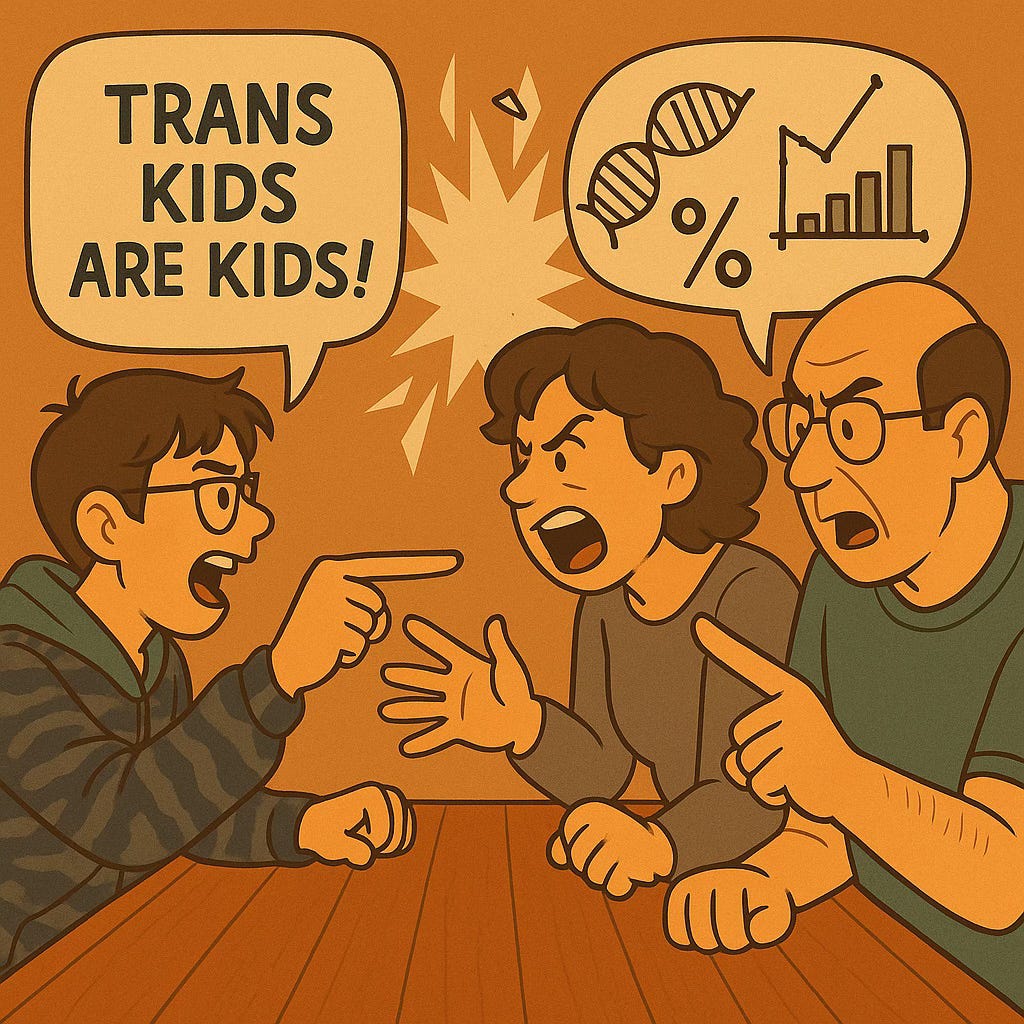



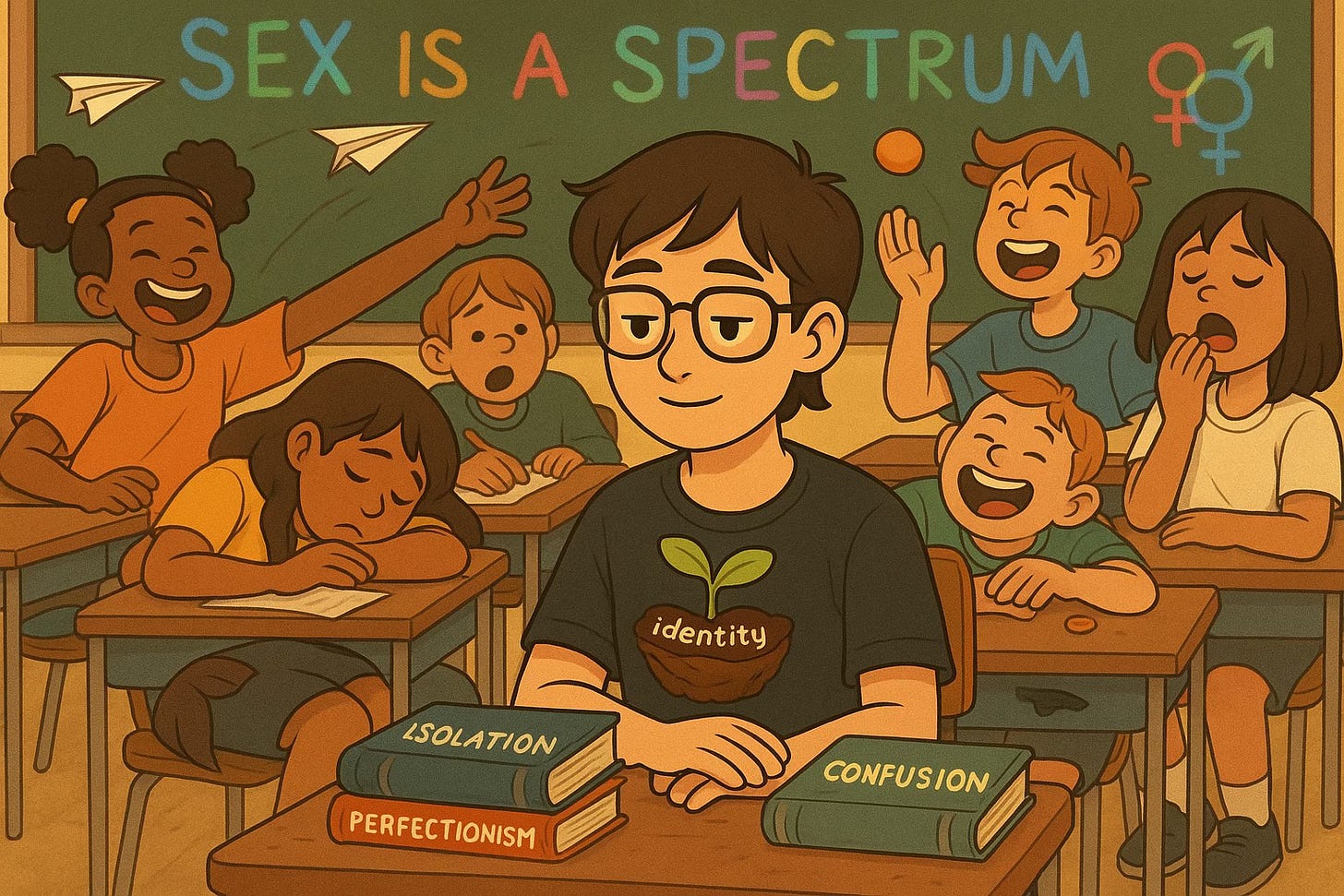
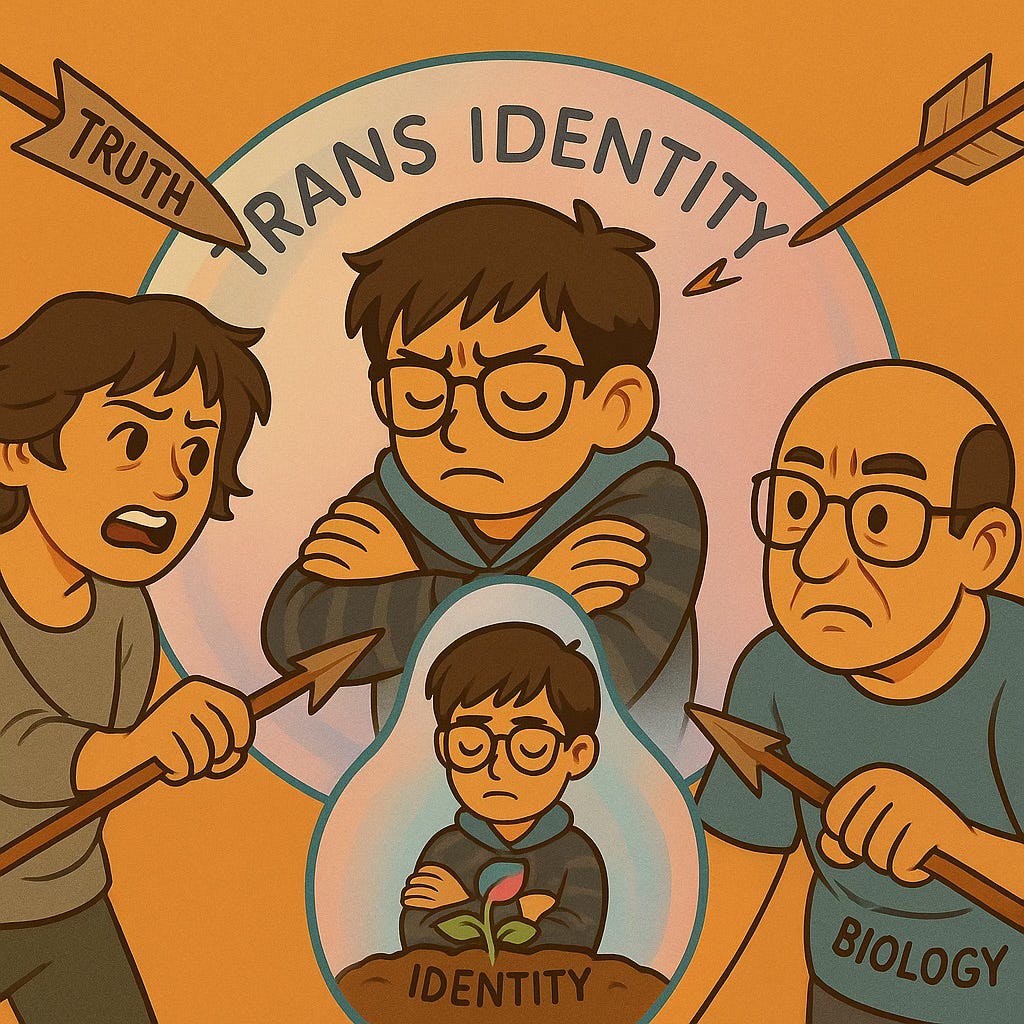





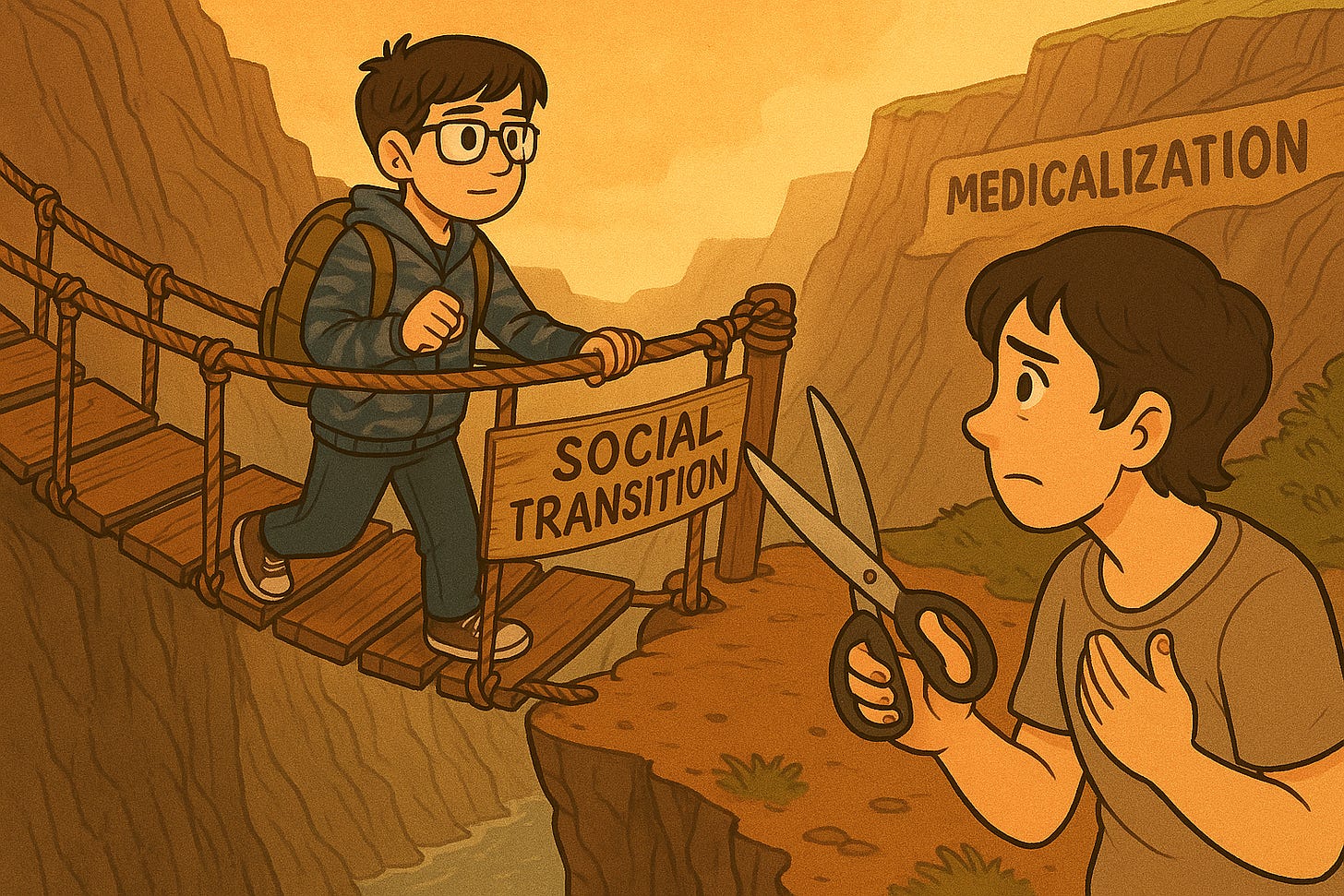










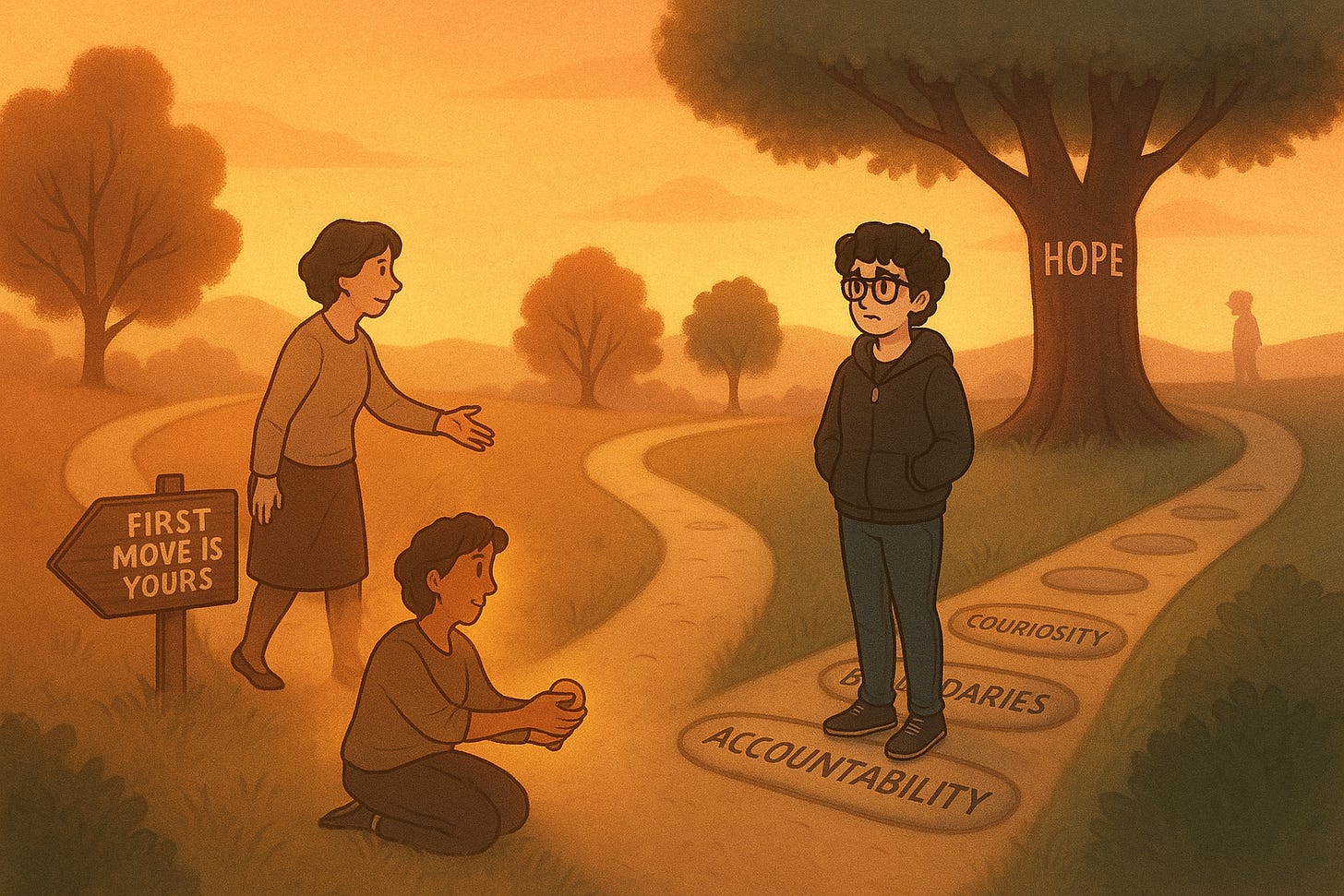






It just dawned on me after digesting your incredible essay that I allowed my daughter’s trans declaration to completely derail my parenting style. Her declaration sent me into panic of despair and grief. She was my little girl one day and a “boy” the next. The problem is I was a loving and authoritative parent for years who became impotent, angry and terrified overnight. I’ve been living in that state since just as she has been living with hers. Your essay has helped me remember the parent I would have been if she had presented with any other issue. I wouldn’t have cowered or become angry or panicked. I would have talked to her, held her and told her we’d figure it out. Instead, I googled what to do, and it told me to affirm and not question. It didn’t feel right, but all that I told her was that I loved her no matter what. My point is that I allowed an ideology to take over as her parent and mine, quite frankly. Thank you for helping me remember that and realize that I have given waaay too much power to this ideology. No, I’m not going to storm into her room with a hammer and destroy her computer and phone (although I’ve thought about it). I’m going to be me again or at least try to be step by step. Thank you!
I must admit that I am not dealing with a gander questioning kid - at this point. I have had to deal with other high risk issues, so your strategies make sense to me. Overwhelming young kids with a tsunami of information and data is pointless because they can't process it. Adolescents will simply shut down when confronted with a long data loaded lecture. My experience has taught me to keep calm, set firm boundaries and keep communication lines open when dealing with my kids. I can panic and rip my hair out later in private